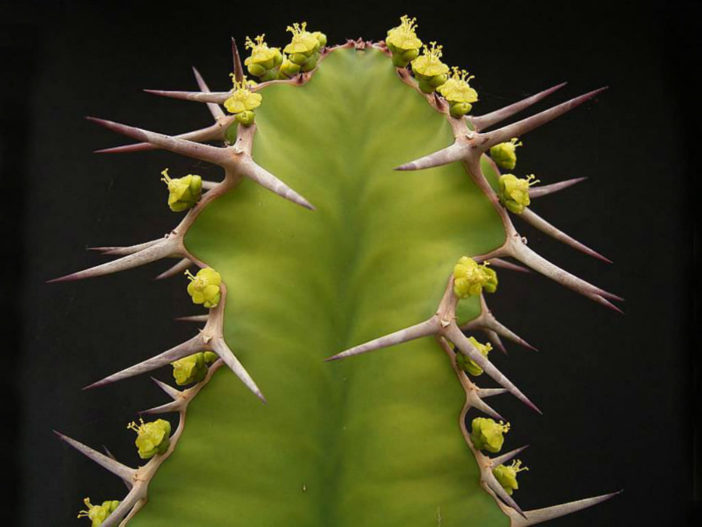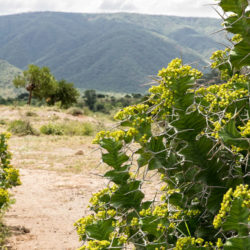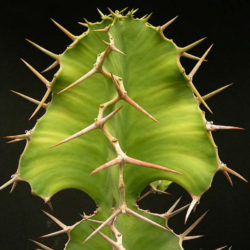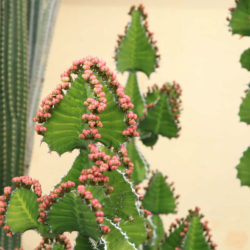Scientific Name
Euphorbia breviarticulata Pax
Common Name(s)
False Cow Horn
Synonym(s)
Euphorbia breviarticulata var. breviarticulata
Scientific Classification
Family: Euphorbiaceae
Subfamily: Euphorbioideae
Tribe: Euphorbieae
Subtribe: Euphorbiinae
Genus: Euphorbia
Origin
Euphorbia breviarticulata is native to Ethiopia, Somalia, Uganda, Kenya, and Tanzania. It grows in sandy soils, silt, and coastal dune remnants in open or dense Acacia-Commiphora bushlands and thickets at elevations that range from 200 to 3,940 feet (60 to 1,200 m).
Description
Euphorbia breviarticulata is a succulent shrub with fleshy, 3- to 4-angled, deeply winged branches with spine shields joined into a continuous horny margin along the angles, enlarged at the base of the spines. It can grow up to 16.4 feet (5 m) tall. The branches are bluish-green branches densely streaked with yellow-green. They are erect and spreading, loosely re-branched, more or less regularly constricted into segments usually broader than long. The angles are wavy with teeth. The spine pairs are robust, reaching up to 3.2 inches (8 cm) long and much shorter at the constrictions. The leaves are tiny, fleshy, deltoid, and quickly deciduous.
Cyathia are up to 0.35 inches (0.9 cm) in diameter, with broadly funnel-shaped involucres and golden yellow glands. They appear 1 to 7 crowded together in spring. The fruits are deeply 3-lobed, green, then reddening capsules that contain pale grey seeds.

Hardiness
USDA hardiness zone 10a to 11b: from 0 °F (−1.1 °C) to 50 °F (+10 °C).
How to Grow and Care
Euphorbias are very easy to care for. They require a little pampering to become established, but once they are, they are self-sufficient. More die from too much care and watering than from neglect. Euphorbias need well-draining soil and lots of sunlight. They are not particular about soil pH, but they cannot tolerate wet soil. Unlike most succulents, Euphorbia does not handle long periods of drought well. It may need weekly watering during the summer. Water whenever the soil is dry several inches below the surface. Water deeply, but don't let them sit in wet soil, which can cause root rot. Add some organic matter or fertilizer to the planting hole. Feed with a half-strength fertilizer monthly if you are growing them in containers or your soil is poor.
Euphorbia can be grown from seed, but they can be difficult to germinate (or even find). It is usually propagated by cuttings. This can be tricky because of the exuding sap. Rooting hormone is recommended with Euphorbias. They tend to grow problem-free, but there are a few pests and diseases to be alert for.
See more at How to Grow and Care for Euphorbia.
Links
- Back to genus Euphorbia
- Succupedia: Browse succulents by Scientific Name, Common Name, Genus, Family, USDA Hardiness Zone, Origin, or cacti by Genus
Photo Gallery
Click on a photo to see a larger version.


